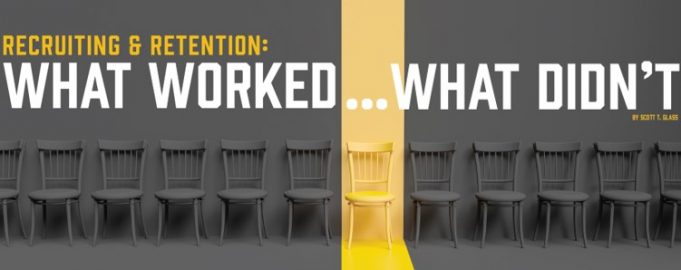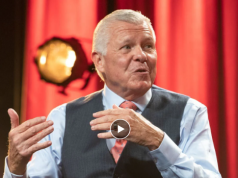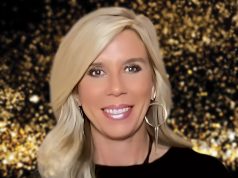By Scott T. Glass
Nearly every officials association in the country is experiencing serious membership shortages. Recruiting new officials is a complex, deliberate organizational task unique to each group. My association — the River City Umpires Association, a baseball-only group in Chattanooga, Tenn. — recognized a shortage during the previous season. Our executive board decided to expand our recruiting effort immediately.
Traditionally the association relied on word-of-mouth recruiting, people moving into the area who had umpire experience and just blind luck. Those added together did not and could not produce enough umpires to sustain our organization.
For the 2021 season, we scheduled umpires for 1,300 games supporting 55 schools in four counties and two states over an area stretching 2,000 square miles. We ended the 2021 regular season with 32 umpires able to accept games.
Games assigned increased 15 percent over six years with new schools and programs adding teams. Since 2015, the association’s list of active umpires declined 66 percent and we had nothing in place to study, address or remedy that trend.
The initial reaction was having umpires work far more games than usual. In the six-year span of 2015-21, my games worked per year more than doubled. Some members worked three times as many games. Doubling or tripling the number of games exhausted umpires, caused work conflicts and irritated family members. We also tried to have umpires drive between games at two geographically separated sites on game days. That method depended on pace of play, traffic and weather.
The association began its 2022 recruiting mission less than 30 days after the 2021 high school state championship concluded. A few specific association members met regularly to go over ideas, discuss implementation, assess what worked and modify what did not work. The key pieces of that strategy involved reassessment, retention, recalls and recruiting tied together with training.
Reassessment
Asking, “Why the decline?” forced a reassessment of how the association did business.
Association leaders endeavored to find out why so many members left the avocation. Once those reasons came to light, board members needed to see if they warranted a change in business practices to retain more members.
Leaders identified several causes for the decline in numbers. They were, in no particular order, age, disaffection, poor communication, poor treatment during games, primary work schedules, family conflicts and lack of advancement.
Age is unavoidable and inevitable. The good news is it could be predicted to a degree. We knew we were not attracting younger umpires and we nearly let that get beyond a remedy. Injury/medical issues, tied with physical fitness and Father Time, forces many umpires to retire. We had no baseball-related injuries that ended careers. However, we lost umpires to hip replacements, blunt force trauma, knee surgery, embolisms, automobile accidents and heart concerns. Those were hard to predict and impossible to fix.
Some umpires left the association due to their perception the games they worked did not reflect their skills and capabilities. That perception caused a third of our losses from previous years. Individuals could be easily identified as those umpires invariably told others as their disaffection grew. Those umpires felt they made all the right choices, put in the years and still did not get “big games” or playoff assignments they wanted. If no one listens to or addresses their concerns, they stop umpiring.
Many umpires who leave the avocation do so because association leaders don’t communicate positively with them. We learned assigners and board members needed to reach out and listen to every umpire periodically. The only risk you take is being organizationally obligated to address their concerns or fix their problems.
Evaluations are a form of two-way communication. They can inspire improvement, encourage standardization and reward consistency. If an association is not regularly evaluating its members, it is missing a communication opportunity.
Behavior toward officials from coaches and fans is horrible. In our assessment meetings, some board members felt we had to take on the issue of umpire abuse as a recruiting and retention issue. It is true a few of our client coaches acted inappropriately and abused all umpires, not just new ones. Some schools’ fans and parents behaved much worse than others and seem proud of their reputation for doing so.
Two of the association leaders requested a meeting with the athletic director of the local public school system, our No. 1 customer by far. The meeting yielded immediate results. We negotiated a pay raise for middle school games and training scrimmages. That was welcomed, to be sure, but the most valuable result was the athletic director confirmed his 100 percent support and willingness to address coach misconduct, parent/fan misbehavior and failure of some schools to address umpire safety.
For one, we could empower even new umpires to correct misbehavior by ejecting the coaches responsible. As long as we followed a reasonable protocol, we would be supported. For another, the athletic director wrote a formal memorandum to each school emphasizing the need to encourage sportsmanlike behavior from coaches. Thirdly, the athletic director agreed to remind and enforce individual school responsibility to provide site administrators for baseball games. A site administrator is one of the key pieces of umpire safety. Traditionally for baseball, the site administrators were either not present or not designated. We trained new umpires on those changes so they could officiate a game and then depart the venue without abuse, threats or intimidation.
Conflicts with an umpire’s primary source of employment proved extremely difficult to work around. That accounted for nearly half of our identified losses last year. Assigners can work to adjust or reduce schedules, but that mechanism tended to impact the schedules of other umpires. Frequent communication with members gave assigners warning a promotion or job move might be imminent and provided some time to adjust. Otherwise, there was no way to predict those changes.
The pandemic seemed to magnify family care concerns. Two valuable members wished to stay home and care for their loved ones. While impossible to predict, that was completely understandable.
About 20 percent of the umpires who were with us at the end of 2021 worked a significant number of games for college conferences. Those umpires perform at a high level and should be encouraged to progress. However, every game they worked at the college level meant we had to schedule more umpires for high school games from a small replacement pool.
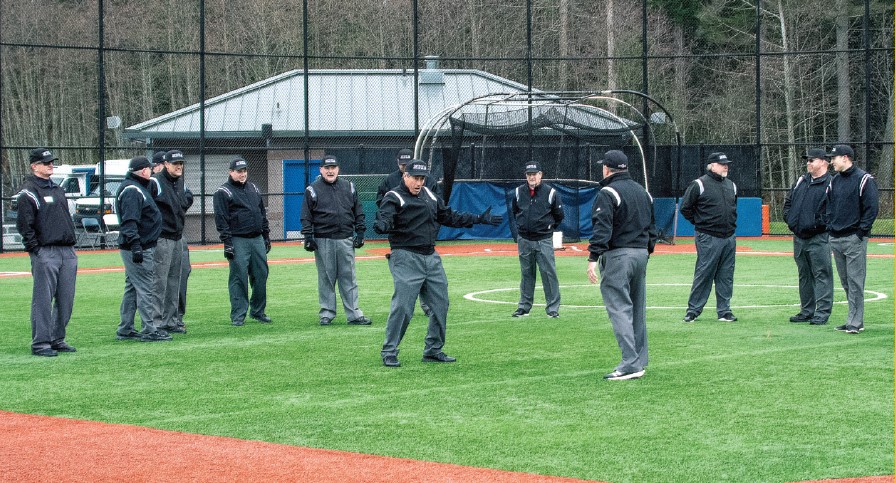
Bill Fitzgerald, Kirkland, Wash. (arms spread) and Terry Granillo, North Bend, Wash. (right) conduct a spring clinic.
Before putting the ball in play in recruiting new members, an association’s leadership must confirm it can assimilate new members properly. We needed to know if we attracted significantly more numbers …
• Did we have a proper training program for new umpires?
• Did we have veteran umpires capable enough to help train them?
• Could the facilities we habitually used for meetings accommodate the increase?
• How many new umpires would overload our current system?
• Could we mentor and evaluate new umpires appropriately?
In asking ourselves those questions, we decided we needed to make some improvements. The association implemented groupings of new and veteran umpires. Each group had a specific training program tailored for it. Specifically, experienced umpires were asked to conduct parts of the training approved by the association’s designated training supervisor. New umpires spent one meeting per week on base umpire topics and the second meeting per week on plate umpire tasks. As it turned out, the system and facilities we used could have easily absorbed twice as many new umpires.
Retention
Trained, veteran and experienced umpires are extremely valuable. Think of all the training time and years of experience invested in them. It makes sense to retain them as long as mutually agreeable. Our association decided we needed to change how we communicated with and trained our valuable umpires.
Our association has a board member specifically tasked with reaching out to everyone on our roster periodically. That works out to roughly twice during the season. His calls ramp up as the preseason approaches in order to determine who will return for another year and who will not. He also is specifically charged with taking complaints, sometimes anonymously. That business practice lets the association make an informed decision about who is dissatisfied for whatever reason and formulate a plan to fix it.
Every umpire enjoys positive, productive interaction with the assigners. An honest appraisal is key to that process. That communication flow in our association did not happen as often or work as well as it should. We increased the number of times leadership reached out to the general members, but that specific skill of evaluation communication is properly done by the assigner.
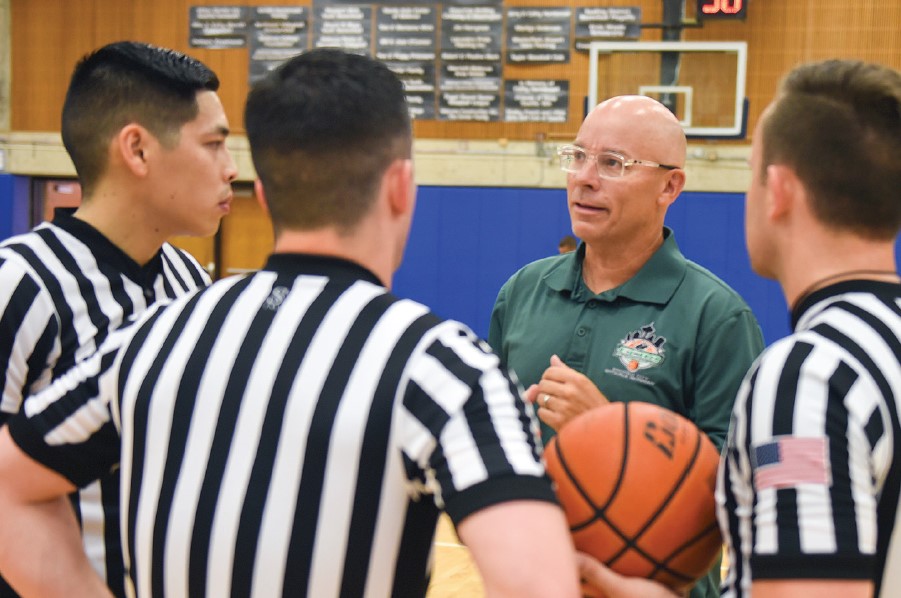
Mark Cook, West Seattle, Wash., gives pointers to (from left) Daniel Nguyen, Seattle; Josh Reed, Spokane Valley, Wash.; and Travis Bain, Seattle.
Evaluations from deliberate visits to watch umpires work fulfill a critical need to tell the umpires what they need to do to call games better and progress. That did not work as well as we wanted in our association. Evaluators need to be honest and forthright in those appraisals and you can’t do that if you do not make the time and place to do them.
We paid special attention to the new umpires joining last year to help them progress in the offseason. We did not want to lose them because of lack of development or training.
Returns
We tried to bring back officials who stopped umpiring in the last two to three years. A useful tool is your association assigning software. Our deputy assigner scoured the list of inactive umpires and began contacting them to get them to consider coming back. Calls, emails and meeting requests went out and six umpires returned for the season.
Whenever someone quits umpiring, be prepared to listen to the reasons why. Determine if you can fix the issue. Then invite them back. Every quality umpire that you can accommodate will add to your numbers.
Recruiting
The association hoped for better numbers from increasing retention efforts and welcoming returning members. However, we determined three months before the season a strong recruiting effort would be the only way to solve our umpire numbers problem.
Association leaders agreed trying more ideas would be better. We knew we could put training in place that could accommodate more gains than we thought possible. We accepted some of the things we tried might not work. We also defined “an idea that worked“ as one yielding at least one umpire who made it through the training and onto any field on opening day.
Ideas that did not work included:
• A sympathetic local newspaper reporter, who had been an association member years ago, wrote articles addressing coach behavior and the shortages of umpires. The articles reached several counties in the publishing area, but produced no contacts. However, going forward we will probably urge more articles covering umpires, including one we want to collaborate on that covers how we recruited that year.
• Our website was not well maintained. All information on it was at least three years old. Invariably, contacts asked about our website. And since we did not have a meaningful one, we probably lost out on some contacts.
Since it was substandard, the association had to rework the website. We approached a local high school media teacher who put us in touch with a high school student who built a serviceable website. We expect it to be a benefit before next season.
• We made pleas on a local AM/FM radio sports talk show. One of our members, who is a local sports media celebrity in his own right, got an invitation for us. The hosts were extremely understanding and supportive. Again, we expected a significant immediate reaction from listeners, but we were disappointed. It produced no contacts of which we became aware. However, we think it will be worthwhile to appear again after the season to report recruiting progress overall.
• The school board that supervised our biggest client school district publishes a monthly job openings newsletter. They were happy to help us advertise. One ad, repeated twice, yielded eight contacts. That was a pleasant surprise, but none of the eight followed through. Two might return for training next year. That is a method we will attempt again next year.
Ideas that worked:
• The association secured an invitation for two board members to appear on a popular sports podcast. We expected some immediate action from listeners, but were disappointed. However, weeks later that produced three contacts who worked games on opening day. We plan to appear on that podcast again in the coming year.
• The same member who arranged the radio appearance secured a spot on a local television show. The TV host was extremely sympathetic and supportive and the station replayed the interview a few times in the following weeks. We will try to do that again after the season to report progress. Eight respondents contacted the association off that appearance. Of those eight, one stepped on the field for opening day.
• Association leaders contacted respected baseball coaches at local schools to refer players or team personnel they thought could grow into good umpires. It did not matter if the coach referred someone still in high school, a graduate, a college player or someone returning home with a college degree. We guessed correctly that could produce a significant number of contacts. We were also correct about the impact. We had seven contacts, but only one of them made it on the field for opening day.
• Recruiting on the field. Last year, we informally encouraged working umpires to respond to any inquiry by a player, coach, fan or anyone connected with the game or teams who asked, “How can I become an umpire?” Over the course of last season we had about eight contacts. One of them made it on the field for opening day.
• It is difficult to predict the success of members recruiting people from year to year. Some members are better at it than others. Some members refuse to do it. Many established umpires are reluctant to do it for fear of recruiting their own replacement or competition. The association found most new members recruited by current members came from a relatively small number of senior umpires who involved themselves in recruiting. That method produced three contacts that completed the training and made it onto the opening day slate of games.
The jury is still out on:
• A local school, employing one of our members, hosted a huge job fair. That member secured a site at the fair, printed some association brochures and attended the fair dressed in his plate gear. On his own initiative, he invited officials representing soccer, softball, volleyball, football and lacrosse. They also appeared in uniform with supporting handouts.
The baseball representative distributed 55 association brochures and gathered 12 written requests for follow-up calls in the offseason. It was too near the start of the season to yield on-the-field results, but that was a great boost for recruiting next year. On a side note, that job fair yielded more than 100 contact sheets and callback requests for information on officiating. The future will tell us how successful we were through the job fair.
New techniques
We developed some areas where we thought our recruiting message would be effective. For manpower or time reasons we could not try them, but we are dedicated to doing so in the coming year.
Chattanooga is home to the Lookouts, a Class Double-A minor league baseball team. We will research the cost of placing ads at the stadium, in team programs and possibly public address announcements during games. At the very least we will ask to set up a recruiting table at some games.
The University of Tennessee-Chattanooga, a member of the Southern Conference, is also nearby. It does not have a conference baseball team but it does support a college club team in the National Club Baseball Association. Board members identified the need to develop contacts in the college and league. There are also four respected college baseball programs in our servicing area in all three NCAA divisions. We plan to place flyers in college employment announcements at all of those schools.
College job fairs will be a challenge since it would require several umpires not in the association leadership to present our message. Still, there are indications that could be successful due to the numerous colleges immediately around us and particularly when we considered the potential success of the high school job fair.
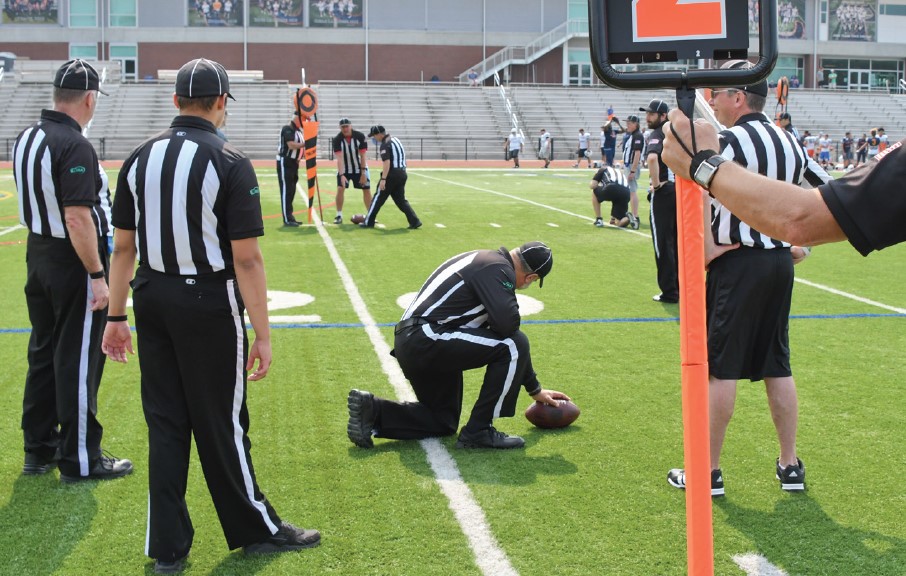
Trying new recruiting and retaining initiatives can’t hurt. But putting energy into efforts with proven track records can boost the chance of success for drawing new officials and keeping veterans.
We thought we needed to develop a mutually beneficial partnership with local youth recreation leagues. That is a natural feeder source for middle school-level umpires. It is well worth considering.
We also need to make sure our recruiting efforts make it clear this avocation welcomes both men and women. Most associations, ours included, have experience with female baseball players who wish to continue involvement in the sport. The country has many female softball players who could easily train to become baseball umpires. What we need to do is raise awareness of the opportunities.
Conclusion
The association will keep looking for methods to attract candidates to train as umpires. We resolved to try new methods once, modify them if needed and try them again.
Our association would love to inform officials everywhere we solved the recruiting and retention problems, and we recruited enough officials to double our onfield strength. But to be honest, we did not even come close to approaching that standard. We did, however, increase our active umpires by 15 percent.
True, our association did increase its raw numbers. But we recruited and trained only enough new umpires to replace our 2021 losses and provide a thin cushion to offset losses anticipated in the approaching year. We broke even, but we avoided disaster. Next year we will build on successes, modify initiatives to be productive and try new things. That was only the first inning in a game we must win.
What's Your Call? Leave a Comment:
Note: This article is archival in nature. Rules, interpretations, mechanics, philosophies and other information may or may not be correct for the current year.
This article is the copyright of ©Referee Enterprises, Inc., and may not be republished in whole or in part online, in print or in any capacity without expressed written permission from Referee. The article is made available for educational use by individuals.

